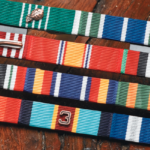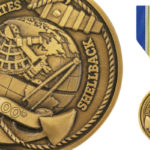The first military medals of the United States clearly showed the country’s elected leadership’s identification with the private soldier, volunteers, militia and a basic avoidance of awards for the professional officer corps.
Marine Corps Brevet Medal came into being reflecting the frustration of Marine Corps officers who were not eligible for the Medal of Honor until 1915. Only when Theodore Roosevelt, a former volunteer officer became President did the Congress begin to truly recognize both volunteers and professional military service. The next six awards on this page were originally only for private Soldiers, Sailors, and Marines.
The Badge of Military Merit was announced in General Washington’s General Orders to the Continental Army on August 7, 1782. Designed by Washington in the form of a purple heart, it was intended as a military order for soldiers who exhibited: “not only instances of unusual gallantry in battle, but also extraordinary fidelity and essential service in any way.” General Washington created three badges, two Honorary Badges of Distinction and a Badge of Military Merit on 7 August 1782. These are the first awards presented to the private soldier as opposed to the European practice of honoring high ranking officers for victory, rather than private soldiers. However, General Washington said, “the road to glory in a patriot army and a free country is open to all”.
The Army Medal of Honor was signed into law on July 12, 1862. To be awarded: “to such non-commissioned officers and privates as shall most distinguish themselves by their gallantry in action, and other soldier-like qualities, during the present insurrection.” The original design of the Army Medal of Honor shows the goddess Minerva fending off a symbol of discord. The thirty-four stars surrounding the figures represent the number of states in the Union. Later in the war, it was approved for award to Army Officers.
The Secretary of the Navy authorized a Good Conduct Badge on April 26, 1869 to help re-enlistments. The badge, a Maltese cross, had the words “FIDELITY – ZEAL -OBEDIENCE” in a circle with “U.S.N.” in the center of the disc. The reverse was for the engraved recipient’s name. A one-half inch wide red, white and blue ribbon was supplied without a suspension pin. Initially, the badge was awarded to “… any man holding a Continuous Service Certificate who: “has distinguished himself for obedience, sobriety, and cleanliness, and is proficient in seamanship and gunnery…” Sailors were presented a separate badge for each discharge and promoted to Petty Officer upon receipt of their third award. It was replaced in 1884 by the now familiar Navy Good Conduct Medal.
The Fidelity Medallion is the oldest of the military decorations of the United States military by act of the Continental Congress in 1780. Commonly known as the “André Medal”, it was awarded to three soldiers who captured British Major John André after he had contacted Benedict Arnold to organize his defection. André was hung as a spy. The face of the medallion contains the inscription “FIDELITY” and the reverse “AMOR PATRIÆ VINCIT”, which means: “The love of country conquers.” The Fidelity Medallion was never again awarded and became regarded as a commemorative military decoration. The Badge of Military Merit is generally considered the first U.S. military decoration although, created two years later in 1782.
The Army Certificate of Merit was issued in medal form between the years of 1905 to 1918. The decoration replaced the much older Certificate of Merit first issued in 1847 for valor in action during the Mexican-American War. Originally only authorized for Privates in 1854 it was approved for Sergeants but never authorized for officers. In 1892, the criteria were changed to include distinguished service in action. Although awarded for non-combat heroism, it was generally awarded for gallantry against the enemy. It could only be awarded once and became obsolete July 9, 1918 with the establishment of the Distinguished Service Cross and Distinguished Service Medal.
The Navy Medal of Valor was signed into law by President Lincoln on December 21, 1861. Soon renamed the Medal of Honor, it was “to be bestowed upon such Petty Officers, Seamen, Landsmen and Marines as shall most distinguish themselves by their gallantry and other seamanlike qualities during the present war.” It was not approved for Officers until 1915.





